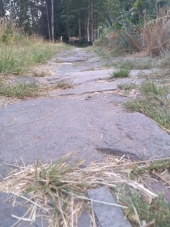posted 6 years ago
Jeremy
There is lots of online info on laying brick (and other material) walkways. More and better expressed than I can do here (pictures, too!). They pretty much all start with a lot of prep. In particular, dig the path down to solid unmolested subsoil. Remove all organic matter (roots, topsoil, etc). Start building up the base with either gravel and/or sand layers. COMPACT each layer in lifts of 2-6". If you use a "jumping jack" compactor, 6" will work; if you're tamping it by hand w/a HomeDepot 12" square hand tamper, 2-3" would be about the limit of a lift for good compaction.
When you get near to level you want the path (maybe an inch or so above grade so there's less chance of standing water?), flatten, level and slope the base carefully. Decide how you're going to establish the surface of your final laying bed (I assume tile, brick or something like that). Decide your pattern or how you're going to deal with irregular stuff like flagstone. Each piece you lay needs to be essentially level with those around it while maintaining flatness and slope.
Many paths want a slightly different edge treatment from the main field. Also, many laid paths want a fairly solid edge to keep the sand and pieces along the edge in place for decades to come. This stuff you figure out before starting; sometimes placing the edge first is best, sometimes not.
After laying the pieces, lay a sheet of 1/8" plywood over them and compact the newly laid pieces, letting the plywood protect the finish and also slightly distribute the forces. This is especially important with brick because the sand in the spaces (sometime very skinny spaces) between the brick needs to be forced in solid - it supports and locks the bricks together and give them their expected strength.
FWIW, the next pathway I do, I plan on placing an impermeable sheet just below the final setting layer; maybe 6mil poly. I hope to prevent plant growth where I don't want it. The impermeable sheet will cause all the water to flow off, so I will have to dig and fill the edges of the path with that drainage water in mind. I may also hammer in (or dig and bury) impermeable sheets straight down 2-3' along the edge of the path, also to discourage roots. However, that may be overkill - I just did a small patio with a _lot_ of _large_ roots near the surface and I may be reacting a little(!).
If you get the idea this is a lot of work... You got it right! Projects have a half life where they go well. After that, even with no problems, any project tends to grow a little stale. Thus for something as labor intensive as this, it might be worth your trouble to carefully search out good labor. Good labor is 1) honest; 2) shows up on time and keeps in contact (calls if there's delays); 3) follows instructions well; 4) works hard, works safely; 5) takes an intelligent interest in what they're doing and is willing to speak up (my rule is people get three tries to promote an idea - either I go with it or we do it my way after that); 6) affordable. #6 is last because it's been my experience that people that do what they say, when they say, and for about the amount they said - are worth almost anything they ask. There is a LOT of time lost when somebody drops the ball one way or another. Finding your great helper takes work and luck, but it's definitely worth the effort when you have (or will have) jobs where there is a cost to stringing it out forever.
Regards,
Rufus

 5
5




![Filename: IMG_1296.jpg
Description: [Thumbnail for IMG_1296.jpg]](/t/99561/a/69830/IMG_1296.jpg)
 4
4




 2
2




 2
2




 1
1




 2
2




 3
3





 4
4




![Filename: unnamed.jpg
Description: [Thumbnail for unnamed.jpg]](/t/99561/a/70609/unnamed.jpg)
 2
2








 3
3











